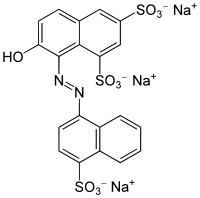Ponceau 4R
| Ponceau 4R | |
|---|---|
 | |
| IUPAC name trisodium (8Z)-7-oxo-8-[(4-sulfonatonaphthalen-1-yl)hydrazinylidene]naphthalene-1,3-disulfonate | |
| Identifiers | |
| CAS number | 2611-82-7 |
| PubChem | 9570119 |
| ChemSpider | 11232342 |
| Jmol-3D images | {{#if:[Na+].[Na+].[Na+].[O-]S(=O)(=O)c4ccc(/N=N/c1c2c(ccc1O)cc(cc2S([O-])(=O)=O)S([O-])(=O)=O)c3ccccc34|Image 1 |
| |
| |
| Properties | |
| Molecular formula | C20H11N2Na3O10S3 |
| Molar mass | 604.47 g mol−1 |
| Except where noted otherwise, data are given for materials in their standard state (at 25 °C (77 °F), 100 kPa) | |
| Infobox references | |
Ponceau 4R (also known as C.I. 16255,[1] Cochineal Red A,[1] C.I. Acid Red 18,[1] Brilliant Scarlet 3R,[1] Brilliant Scarlet 4R,[1] New Coccine[citation needed]), SX purple[citation needed]) is a synthetic colourant that may be used as a food colouring. It is denoted by E Number E124.[1] Its chemical name is 1-(4-sulpho-1-napthylazo)- 2-napthol- 6,8-disulphonic acid, trisodium salt. Ponceau (French for "poppy-coloured") is the generic name for a family of azo dyes.
Ponceau 4R is a red azo dye which can be used in a variety of food products, and is usually synthesized from aromatic hydrocarbons from petroleum.
Health effects
Because it is an azo dye, it may elicit intolerance in people allergic to salicylates (aspirin). Additionally, it is a histamine liberator, and may intensify symptoms of asthma.
Ponceau 4R is considered carcinogenic in some countries, including the US, Norway, and Finland, and it is currently listed as a banned substance by the US Food and Drug Administration (FDA).[2] Since 2000, the FDA has seized Chinese-produced haw flakes (a fruit candy) on numerous occasions for containing Ponceau 4R.[3]
The EFSA has decided on 2009-09-23 to lower the Acceptable Daily Intake (ADI) for Ponceau 4R from 4 mg/kg to 0.7 mg/kg bodyweight per day. The substance causes increased migration of nuclear DNA in glandular stomach, bladder (≥ 100 mg/kg) and colon tissue (≥ 10 mg/kg). Clastogenic activity was seen in bone marrow at dosages equivalent to an intake ≥ 80 mg/kg, but no carcinogenic effects were noted.
The production process may result in unsulphonated aromatic amines present in concentrations of up to 100 mg/kg which may be linked to cancer. Also the EFSA panel noted that the JECFA limit for lead is ≤ 2 mg/kg whereas the EC specification is ≤ 10 mg/kg. The colour additive can also increase the intake of aluminium beyond the tolerable weekly intake (TWI) of 1 mg/kg/week. Therefore the limit for aluminium may be adjusted to accommodate for this.[4]
Possible cause of hyperactivity
On 6 September 2007, the British Food Standards Agency revised advice on certain artificial food additives, including E124.
Professor Jim Stevenson from Southampton University, and author of the report, said: "This has been a major study investigating an important area of research. The results suggest that consumption of certain mixtures of artificial food colours and sodium benzoate preservative are associated with increases in hyperactive behaviour in children.
"However, parents should not think that simply taking these additives out of food will prevent hyperactive disorders. We know that many other influences are at work but this at least is one a child can avoid."
The following additives were tested in the research:
- Sunset yellow (E110) (FD&C Yellow #6) - Colouring found in squashes
- Carmoisine (E122) - Red colouring in jellies
- Tartrazine (E102) (FD&C Yellow #5) - Yellow colouring
- Ponceau 4R (E124) - Red colouring
- Sodium benzoate (E211) - Preservative
- Quinoline yellow (E104) - Food colouring
- Allura red AC (E129) (FD&C Red #40) - Orange / red food dye[5][6][7][8][9][10]
On 10 April 2008, the Foods Standard Agency called for a voluntary removal of the colours (but not sodium benzoate) by 2009.[11] In addition, it recommended that there should be action to phase them out in food and drink in the European Union (EU) over a specified period.[12]
The EFSA (European Food Safety Agency) has found the results of the Southampton study to be ambiguous and inconclusive and recommends no changes to current EU regulations pending results of further well designed testing of colourants.[13]
UK ministers have agreed that the six colourings will be phased out by 2009.[14] Yet it is still used in the Scottish soft beverage Irn-Bru, according to Sky News.[15]
References
- ↑ 1.0 1.1 1.2 1.3 1.4 1.5 http://www.fda.gov/downloads/Food/GuidanceComplianceRegulatoryInformation/ComplianceEnforcement/ucm072848.pdf Food and Drug Administration Compliance Program Guidance Manual, Chapter 03 - Foodbourne Biological Hazards, p37
- ↑ Food And Drug Administration Compliance Program Guidance Manual p.10
- ↑
- ↑ "EFSA Scientific Opinion on the re-evaluation of Ponceau 4R (E 124) as a food additive". 091113 efsa.europa.eu
- ↑ Parents warned of additives link
- ↑ Graham Tibbetts. "Artificial colourings as harmful as leaded petrol for children", Telegraph, 7 April 2008
- ↑ "Artificial food colouring warning", BBC News, May 8, 2007.
- ↑ Felicity Lawrence, "New fears over additives in children's food", The Guardian, May 8, 2007.
- ↑ Laura Clout, "Warning over food additives", The Telegraph, May 8, 2007.
- ↑ Graeme Paton and Adam Stones, "New evidence links E-numbers to hyperactivity", The Telegraph, May 9, 2007.
- ↑ BBC Europe-wide food colour ban call 10 April 2008
- ↑ FSA Board discusses colours advice 10 April 2008
- ↑ EFSA Assessment of the results of the study by McCann et al. (2007) on the effect of some colours and sodium benzoate on children’s behaviour 8 March 2008
- ↑ BBC Ministers agree food colour ban 12 November 2008
- ↑ Sky News Marmite Seized In Canada Customs Crackdown 24 January 2014
External links
- Technical Data Sheet Ponceau 4R of CORALIM aditivos www.coralim.com
- Carcinogenic Potency Database Project entry for SX purple, alias Ponceau 4R
- Some more details, other common names
See also
- Ponceau family of Azo dyes